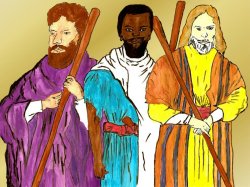Idols sold as commodities on the stock market

Today in the western world (in Europe, and USA) this culture of the Canaanites, the worshiping of many spirits and gods has infiltrated into the medical system, art, movies, music, and everyday life of the people. people buy nail mats, use medication, buy goods, go for massage programmes, eat in Asian restaurants, do meditation in yoga positions that are dedicated and used as instruments of worship for these Asian spirits and gods
The buying and selling of idols also called idolatry (items worshiped as gods), was introduced into the world traditions and religious system by the man called Nimrod.
Nimrod as an astrologer, a sorcerer and witch, who desired to be worshiped as a god, in his invention he decided to come up with a stock market that sells idols so that he may establish his kingdom called Babel as in Genesis 11:1-9.
The word Babel means; the gate way of many gods, or the worship of many spirits or the worship of the spirit in everything or nature being the process through which the idols that are worshiped as gods turn into images of fantasy in the mind.
And the from the word Babel derives the word called Babylon.
During the building of the tower of Babel as in Genesis 11:9, God confused the people that were building the tower of Nimrod or Babel (city of rebellion against God),
and from that time, the people that were speaking one language (Hebrew) began to speak many languages, and they also became a people of different cultures and traditions.
From the black son of Noah called Ham, the father of Cush (the word Cush means black complexion), also being the grandfather of Nimrod, there came forth a culture or a tradition of people called the Canaanites as in Genesis 10:6, the sons of Ham were Cush, Mizraim, Put, and Canaan.
Hosea 12:7 says; A cunning Canaanite! deceitful scales (or evil business skills) are in his hand; he loves to oppress.
The word Canaanite means; a culture of unclean merchants that sells and worships idols for living. Through the culture of merchants that derived their mindset and way of doing things from Nimrods pagan worship,
these Canaanites began to spread as far as Asia, the culture of selling idols and attaching them with a spiritual influence (worshipping the spirit that is contained in a physical thing), became a systematic life style that governed the people’s future and fortune.
For example; Nimrod’s Babylonian economic system (stock market) had invented a god for everything, gods inform of idols (stars, sun, moon, statues of naked women or men, dragons, images of men with six or more hands, witchcraft symbols and signs, images of kings etc),
were sold into people’s lives as tokens of good luck (some were gods of joy, pregnancy, fame, wealth etc), for every success and spiritual pursuit in life, there was an idol that governed its event.
The Canaanite culture (merchants that sold idols, and also worshiped their spiritual beings) spread as far as Asia (India, china, Mongolia, Malaysia, Indonesia, Thailand, Vietnam, Pakistan, Korea, etc)
Later in history, the dependence upon these idols and their worship was transformed into religions, the religion of Buddhism emerged roughly between the year 563 and 483 BCE (4th century),
from the man called Siddhartha Gautama, also called Buddha, the son of king Suddhodana of Nepal, born in Lumbini of Nepal, near India border.
In Buddhism the image of this man called Buddha (Siddhartha Gautama) is worshiped as a god.
The religion of Hinduism emerged in India around the 2nd century BCE, where an image with an elephant head is worshiped as a god or goddess.
During the 5th century BCE in China from the teachings of Confucius emerged a religion called Confucianism, where physical images that represented spiritual gods where worshiped as mediators between the people and the spirits that they desired to contact in the spiritual realm.
Through these three religions (Confucianism, Buddhism, and Hinduism) the whole entire continent of Asia was filled with idol worship and spirits that originates from Nimrod (tower of Babel).
By Apostle A. Ngabo



